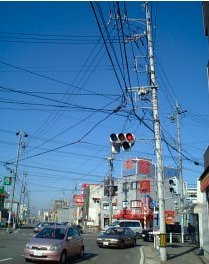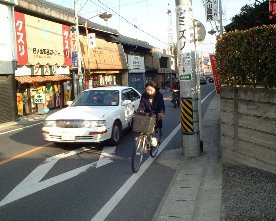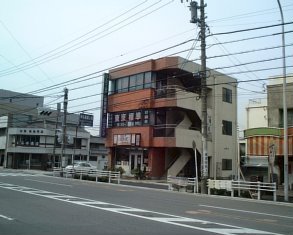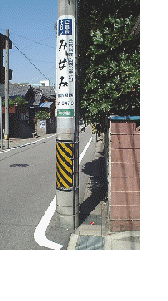![]()

A townscape surrounded by telegraph poles and all kinds of
wires in the sky is
something like a messy construction site or a back stage.
Beautiful blue sky in
fall may not look impressive when you see it through the wire
web. Web created
by spider has much order than the wire web in the sky. If you
take a closer look,
you'll find telegraph poles are not always vertical. They are
leaning this way and
that way. They are well decorated with billboards and protectors
painted in black
and yellow. They are messy enough to damage the harmony in
landscapes.
Japan used to be a country where people enjoyed aesthetics in
simplicity and
beauty of harmony of the nature. For instance, the sofistication
in Japanese archi-
tecture is well known worldwide. A Japanese gardening method, Shackei
(Arranging
garden utilizing the background landscape) show how people put
importance on envi-
ronmental harmony. Tea ceremony which was created by Sen no Rikyu
and Haiku, the
shortest form of poem, are also good example in which people
loved and cared about
beautiful Japanese landscapes. It was a paradime in those days.
However, nowadays, such sense is not common. I think there could
be a causal
relationship between aesthetic sense of modern Japanese and the
telegraph poles
because the telegraph poles have totally changed Japanese
landscapes.
You may possibly have an experience that you were scared, when
walking down a
street with no pedestrian way, as you were almost sandwiched in
between a car
and a telegraph pole. Telegraph poles are occupying precious
space in narrow
streets and are often big obstacles for pedestrians and bikers.
But still they have to
use such streets for commuting and shopping. This happens
everywhere in Japan.
An electric power company mentioned, to my inquiry, that
roughly 3000 telegraph
poles were collapsed at the big earthquake in Kobe in 1993. They
say most of them
were collapsed because nearby buildings had hit them. Well, I
think it is no wonder
telegraph poles with heavy transformer on it's top are collapsed
by earthquake
like one in Kobe. Anyway, many poles were collapsed and power
lines and
communication lines were cut off. Furthermore, acording to the
victims, some
part of roead became very slippery because of the oil leaked out
from fallen
transformers. Fire engines and ambulances were brought up to
standing still
due to telegraph poles lay across the road.
There is more trouble. Telegraph poles and wire web interfere
with fire fighting
and rescue work upon fire. Sometimes, high performance ladder
truck can be
useless under wire web.


Most of telegraph poles are equipped with billboards. Come to
think of it, it dose
not make sense. Telegraph poles on roads are defined as
"road occupying object"
under a law and the space is rent at reasonable price. Electric
power companies
pay about 2,000 yen per pole annually to citys or prefectures to
which roads belong to.
It makes sense because telegraph poles have something to do with
public interest.
However, electric power companies or their affiliated companies
charge somewhere
around 15,000 yen as annual advertisement fee and 10,000 yen as
billboard fee on
each billboard put on telegraph poles. One electric power company
has about 300,000
billboards in their area and that means 450 million yen annual
sales by advertisement
fee alone. As they increase the number of telegraph poles, their
advertising business
oppotunity grow. It dose not make sense that public space is
provided for profitable
business purpose under public purpose. Billboards are sometimes
against public interest.
For instance, you might be unhappy if a billbord of dental or
nasal clinic is put up right in
front of your brand new house. These billboards often have small
notes of address of the
location but that seems to be an easy excuse.

Application of underground wire system is on its way.
According to the anouncement
by Ministry of Land, Infrastructure and Transport, 1.1% of the
roads in cities with
population of over 100,000 have underground wire system in 1998.
And the rate will
be raised up to 2.1% by 2005 in their new plan. Then, if they
kept this pace, it will
take 685 years to complete the rest. It seems like that they are
not serious.
Even it is slow, there is a progress. However, according to their
plan,the application
is now concentrated only on main streets in business district,
shopping district or
newly developed residential area . The intention is to promote
business or to improve
area with high attension. Well, putting the priority on such
districts make sense to some
extent. However, telegraph poles are considered as much bigger
trouble at rather
old and narrow streets where pedestrians or bikers use them in
daily shopping and
commuting . The ministery's plan of underground cable system is
not reflecting people's
needs very well.
In my assumption, there are there reasons why the progress of
Japan's underground
wire system is so slow.
1. It is noted in the new plan of Ministry of Land,
Infrastructure and Transport
that pedestrian road should be more than 2.5m wide,
preferably 3.5m wide,
when applying underground wire system because
transformers need to be
installed on surface. However, there are not so many
wide pedstrian roads in
Japan. In Paris, Frankfurt or London, there are many
narrow streets almost
unchanged from medeaval days but wires are laid
underground nearly 100%.
Japan's technology of undergroud cable system could
be out of date.
2. Underground wire system is very expensive. They say
overhead wire system
cost from 13 millinon to 30 million yen per
killometer whereas underground
system for electric wires alone cost 200million to
300million yen. If other
wires such as telephon wires and CATV wires are
installed together, it may
cost 600million or more they say. That is somthing I
have found out. They say,
when applying condits under the ground, you have to
move water, sewage and
gas pipes and that makes the work expensive. But it
just digging and installing
still. It can be less expencive if Japan's high
engineering technology is seriously
used.
3.There is a possibility that someone is not willing to
change from overhead system
to underground system. Billboard business on telegraph
poles could have somthing
to do with the slow progress.